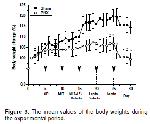Our results demonstrate that melatonin has a
stimulatory effect on food intake in mice. The previous
studies also showed that melatonin treatment increased
food intake in mice
12. To determine whether or not
melatonin may regulate food intake physiologically,
pinealectomy was performed. The pinealectomized
animals had lower food intake, which shows melatonin
may have an effect on food intake not only
pharmacologically but also physiologically as well.
Neither vehicles nor sham operation caused any
significant changes in food intake.
Melatonin may have a role in the regulation of food
intake for many reasons. Our previous studies15,16
and other studies4,18, showed that melatonin
decreases serum leptin levels in rats. The leptindecreasing
effect of melatonin is expected to lead to higher food intake because diminution of leptin
stimulates food intake. In the present experiment, the
stimulatory effect of melatonin on food intake might occur
due to the influence of melatonin on leptin release
although the levels of serum leptin have not been
measured.
The fact that melatonin has different effects on food
intake in animal species may be due to its different
effects on ghrelin secretion. Ghrelin is known to increase
appetite of rodents9. In the animal species such as
rats in which melatonin decreases plasma ghrelin levels17, it has an inhibitory effect on food intake whereas
melatonin treatment results in a higher food intake in the
voles13. The stimulatory effect of melatonin on food
intake in the voles may have been mediated via elevated
ghrelin levels of the melatonin-treated animals.
Melatonin has been suggested to be useful for the
treatment of neoplastic cachexia in human because
melatonin was found to stimulate appetite by decreasing
TNF secretion20. Determination of the effect of
melatonin on the appetite - regulating hormone such as
leptin and ghrelin in human may help the exact
mechanism by which melatonin exerts its effect on
appetite to be established.
To determine the mechanism by which melatonin
exerts its stimulatory effect on food intake in mice, a
melatonin antagonist, luzindole (MT2 receptor antagonist)
was used. Luzindole did not reverse the increase in food
intake caused by melatonin. It was suggested that
Melatonin shows an inhibitory effect on food intake in rat14 and goldfish via luzindole-sensitive melatonin
receptors11. Thus, stimulatory and inhibitory effects of
melatonin appear to be mediated by different
mechanisms.
Plasma glucose concentration has an important role
in the regulation of food intake. As plasma glucose
concentration increases, brain satiety mechanisms are stimulated21 resulting in a decrease in food intake or
vice versa. It has been reported that pinealectomy leads
to an increase in plasma glucose concentration22,
which may cause a decrease in food intake. So, the
decrease in food intake following pinealectomy may have
resulted from an increase in plasma glucose
concentration, which stimulates brain satiety
mechanisms. In that study, melatonin replacement has
been shown to restore 24-h mean plasma glucose
concentrations in pinealectomized rats.
In the present experiment, leptin administration
resulted in a lower food intake in both shampinealectomized
and pinealectomized rat. The efficiency
of leptin in reducing food intake were similar in the two
groups, which shows pinealectomy did not cause a
further enhancement in the effect of leptin on food intake.
The body weights of the animals were daily
measured during the experimental study. Until leptin
injection, which was performed on 25 day, the body
weights of the groups tended to increase. Leptin injection
decreased body weights in sham–operated and
pinealectomized animals. Percentage decrease in body
weight was higher in the pinealectomized group (5.2%)
compared with sham-operated group (0.4%). Thus,
melatonin seems to prevent leptin-induced decrease in
body weight.
In conclusion, melatonin was found to increase food
intake physiologically and pharmacologically in mice.
Further studies are needed to determine the mechanism
by which melatonin exerts its effect on food intake in
mice.
Acknowledgements
The authors thank Dr. Bayram Yilmaz of University at
Yeditepe, Faculty of Medicine, Department of Physiology
for his critical review of the manuscript.





